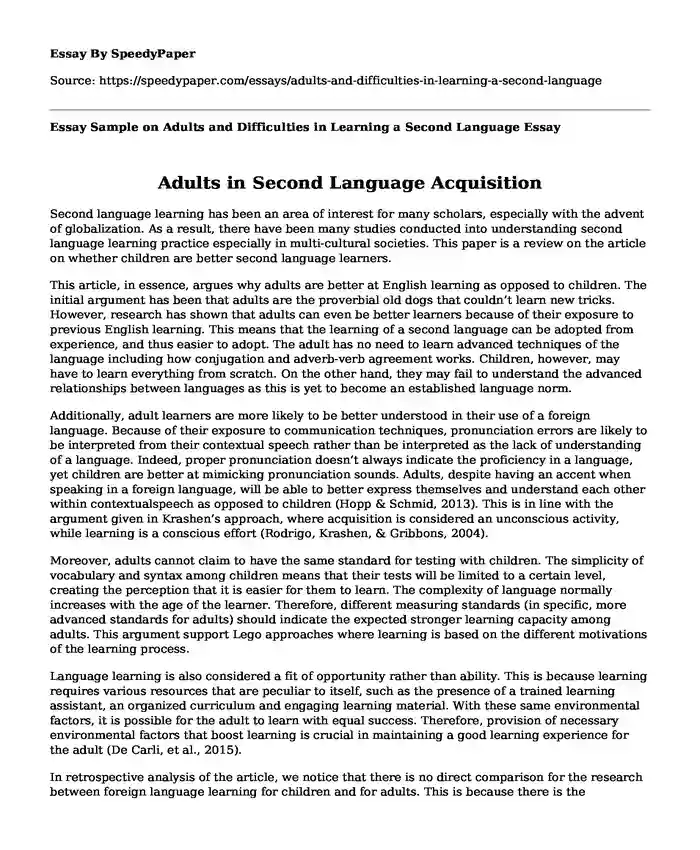Adults in Second Language Acquisition
Second language learning has been an area of interest for many scholars, especially with the advent of globalization. As a result, there have been many studies conducted into understanding second language learning practice especially in multi-cultural societies. This paper is a review on the article on whether children are better second language learners.
This article, in essence, argues why adults are better at English learning as opposed to children. The initial argument has been that adults are the proverbial old dogs that couldn’t learn new tricks. However, research has shown that adults can even be better learners because of their exposure to previous English learning. This means that the learning of a second language can be adopted from experience, and thus easier to adopt. The adult has no need to learn advanced techniques of the language including how conjugation and adverb-verb agreement works. Children, however, may have to learn everything from scratch. On the other hand, they may fail to understand the advanced relationships between languages as this is yet to become an established language norm.
Additionally, adult learners are more likely to be better understood in their use of a foreign language. Because of their exposure to communication techniques, pronunciation errors are likely to be interpreted from their contextual speech rather than be interpreted as the lack of understanding of a language. Indeed, proper pronunciation doesn’t always indicate the proficiency in a language, yet children are better at mimicking pronunciation sounds. Adults, despite having an accent when speaking in a foreign language, will be able to better express themselves and understand each other within contextualspeech as opposed to children (Hopp & Schmid, 2013). This is in line with the argument given in Krashen’s approach, where acquisition is considered an unconscious activity, while learning is a conscious effort (Rodrigo, Krashen, & Gribbons, 2004).
Moreover, adults cannot claim to have the same standard for testing with children. The simplicity of vocabulary and syntax among children means that their tests will be limited to a certain level, creating the perception that it is easier for them to learn. The complexity of language normally increases with the age of the learner. Therefore, different measuring standards (in specific, more advanced standards for adults) should indicate the expected stronger learning capacity among adults. This argument support Lego approaches where learning is based on the different motivations of the learning process.
Language learning is also considered a fit of opportunity rather than ability. This is because learning requires various resources that are peculiar to itself, such as the presence of a trained learning assistant, an organized curriculum and engaging learning material. With these same environmental factors, it is possible for the adult to learn with equal success. Therefore, provision of necessary environmental factors that boost learning is crucial in maintaining a good learning experience for the adult (De Carli, et al., 2015).
In retrospective analysis of the article, we notice that there is no direct comparison for the research between foreign language learning for children and for adults. This is because there is the phenomenon that one activity is conscious learning, where in the case of children it is acquisition. Comparable to Krashen’s approach, adult learners are more likely to adopt new languages as they are aware of the basics of speech and language during the language process and are more perceptive to new language information. Furthermore, the Lego approach asserts that different motivations are necessary for the adequate and effective learning of a second language. As found in the research, it is not so much about ability as it is about making efficient use of the opportunity to learn. After making use of these steps, adults could possibly outdo children in the acquisition of a new language. In conclusion, it could be said that as opposed to arguing ability, adults should make use of proper resources to empower them to perform better when learning foreign languages.
References
De Carli, F., Dessi, B., Mariani, M., Girtler, N., Greco, A., Rodriguez, G., & Morelli, M. (2015). Language use affects proficiency in Italian–Spanish bilinguals irrespective of age of second language acquisition. Bilingualism: Language and Cognition, 18(02), 324-339.
Hopp, H., & Schmid, M. S. (2013). Perceived foreign accent in first language attrition and second language acquisition: The impact of age of acquisition and bilingualism. Applied Psycholinguistics, 34(02), 361-394.
Rodrigo, V., Krashen, S., & Gribbons, B. (2004). The effectiveness of two comprehensible-input approaches to foreign language instruction at the intermediate level. System, 32(1), 53-60.
Cite this page
Essay Sample on Adults and Difficulties in Learning a Second Language. (2017, Oct 20). Retrieved from https://speedypaper.com/essays/adults-and-difficulties-in-learning-a-second-language
Request Removal
If you are the original author of this essay and no longer wish to have it published on the SpeedyPaper website, please click below to request its removal:
- Marketing Essay Sample on The Coca-Cola Company and Diet Coke
- Free Essay Example about the Cognitive Dissonance Concept
- Essay Sample on Excess Packaging in Retail Stores
- Ventilation and Warming, Nursing Essay Example
- Article Review Essay on Diabetes among Hispanics: All Are Not Equal by Alexandria, Virginia
- Free Essay Example: A Victim of Violence
- Essay Sample on Emergency Department Ratio Analysis
Popular categories





